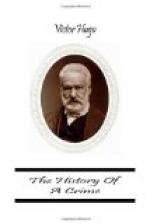The stream of people driven back from the Boulevards and from the Rue Richelieu flowed towards the Rue de la Paix. We recognized there some of the Representatives of the Right who had been arrested on the 2d, and who were already released. M. Buffet, an ex-minister of M. Bonaparte, accompanied by numerous other members of the Assembly, was going towards the Palais Royal. As he passed close by us he pronounced the name of Louis Bonaparte in a tone of execration.
M. Buffet is a man of some importance; he is one of the three political advisers of the Right; the two others are M. Fould and M. Mole.
In the Rue Monthabor, two steps from the Rue Saint Honore, there was silence and peace. Not one passer-by, not a door open, not a head out of window.
In the apartment into which we were conducted, on the third story, the calm was not less perfect. The windows looked upon an inner courtyard. Five or six red arm-chairs were drawn up before the fire; on the table could be seen a few books which seemed to me works on political economy and executive law. The Representatives, who almost immediately joined us and who arrived in disorder, threw down at random their umbrellas and their coats streaming with water in the corner of this peaceful room. No one knew exactly what was happening; every one brought forward his conjectures.
The Committee was hardly seated in an adjoining little room when our ex-colleague, Leblond, was announced. He brought with him King the delegate of the working-men’s societies. The delegate told us that the committee of the societies were sitting in permanent session, and had sent him to us. According to the instructions of the Insurrectionary Committee, they had done what they could to lengthen the struggle by evading too decisive encounters. The greater part of the associations had not yet given battle; nevertheless the plot was thickening. The combat had been severe during the morning. The Association of the Rights of Man was in the streets; the ex-constituent Beslay had assembled, in the Passage du Caire, six or seven hundred workmen from the Marais, and had posted them in the streets surrounding the Bank. New barricades would probably be constructed during the evening, the forward movement of the resistance was being precipitated, the hand-to-hand struggle which the Committee had wished to delay seemed imminent, all was rushing forward with a sort of irresistible impulse. Should we follow it, or should we stop? Should we run the risk of bringing matters to an end with one blow, which should be the last, and which would manifestly leave one adversary on the ground—either the Empire or the Republic? The workmen’s societies asked for our instructions; they still held in reserve their three or four thousand combatants; and they could, according to the order which the Committee should give them, either continue to restrain them or send them under fire without delay. They believed themselves curtain of their adherents; they would do whatever we should decide upon, while not hiding from us that the workmen wished for an immediate conflict, and that it would be somewhat hazardous to leave them time to become calm.




